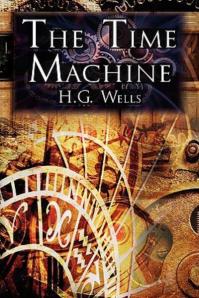The Time Machine
First, some fun facts and context
- H. G. Wells (1866-1946) and his sci-fi classic of course predate the word “steampunk.” It even predates the term “science fiction.” In his own time, works like the Time Machine were called “scientific romances.” I believe it should be considered steampunk because it is a look into a futuristic past that never was, which means it is rife with possibilities for reinterpretation (like K. W. Jeter’s Morlock Nights) and the description of the machine itself has a definite steampunk gestalt due to the time period in which it was written. I wasn’t able to find any images of the machine from the original 1949 teleplay, but it is easy to find images and models of the iteration used in the 1960 film (pictured below).
- The book was actually published first as a serial novella in a magazine in 1895, and Wells received $100 upon completion. In the original serial Wells’ editor insisted on an extra stop in time and different type of human. This section was dropped when the whole story was compiled into a book, but you can still read the missing text at http://en.wikisource.org/wiki/The_Grey_Man
- This story was the first time the term “time machine” was ever used, but not the first story Wells wrote about time travel. He published a short story 7 years earlier entitled The Chronic Argonauts. (You can read the full text at a variety of places on the web because in the USA it is no longer under copyright. For instance, http://www.colemanzone.com/Time_Machine_Project/chronic.htm,)
- Novels too wordy? You have several visual adaptations to choose from. A faithful feature film was made in 1960, a reinterpretation starring Guy Pierce in 2002 and it has also been reproduced as a graphic novel by Terry Davis.
Synopsis: The main character, only ever referred to by the narrator as “the Time Traveler,” explains to a group containing enthusiasts and skeptics in equal measure that time is the fourth dimension and he has engineered a way to travel through it. After showing them a demonstration using a model of his machine, he invites his guests to return in one week at which time he promises proof of his claim. A week later the others have all assembled around the Time Traveler’s table but the host is nowhere to be seen. He soon stumbles in ragged and distressed, and tells them of his harrowing adventure into the year 802,701 A.D. (influenced in no small part part Wells’ own socialist leanings) where humans have split into two distinct species. He first meets the gentle and incurious Eloi, what he later comes to think of as the heirs to an artistocratic past that removed the challenges of survival and therefore the need for intelligence. Like cattle, they are simultaneously provided for and consumed by Morlocks, who live a subterranean existence and continue to work on mysterious machinery in total darkness deep under the earth.
The Time Traveler’s journey takes him across the future landscape of Surrey which includes huge decaying structures like a museum (a metaphorical time machine allowing a glimpse into the past while the scientific ingenuity of his present brought him forward) covered with writing that can no longer be understood by the inhabitants of this new world. He also makes a friend in the form of an Eloi female named Weena, whom the Time Traveler rescues from drowning early on in his trip, but later loses her life because of his exploits. After he escapes from 802,701, he heads further into the future and encounters the red giant the sun has become and a rapidly cooling landscape void of any animal life but elephant-sized crabs.
Upon his return he tells his tale to his assembled guests, none of whom seem to believe him. The narrator wakes the next morning and feels the need to discuss the journey further, and arrives to find the Time Traveler about to embark on another sojourn in search of proof. He asks the narrator to wait for half an hour and all will be illuminated, but three years later he has not returned. In the epilogue, the narrator speculates about where the Time Traveler has gone and if he will ever return. He revisits the Time Traveler’s interpretation of his first journey, namely that the human race will completely devolve and his lamentation over the loss of intellect, but himself is heartened by the descriptions of tenderness and friendship between the Time Traveler and Weena.



























































































Lovely web site! I ran across the item when shopping about Bing News. Have you got virtually any easy methods to get marketed in Askjeeve Information? I am attempting for a while having said that i under no circumstances seem to arrive there! With thanks
LikeLike
November 1, 2013 at 6:21 pm
Hello! I am thrilled to hear you found me so easily, but honestly I have done nothing so far to market my blog. I am still working on a logo, etc so I did a “soft opening” about a week ago. One thing I have made sure to do is add as many tags to each post as possible so search engines would find them. If you don’t know what I mean by “tag” you can read about it here: http://www.masternewmedia.org/news/2008/04/01/content_tagging_what_are_tags.htm
Good Luck!
LikeLike
November 3, 2013 at 12:45 pm
Pingback: Steampunk Book Review: Morlock Night | For Whom the Gear Turns
Pingback: Steampunk Book Review: War of the Worlds | For Whom the Gear Turns
Pingback: Steampunk Book Review: First Men in the Moon | For Whom the Gear Turns
Pingback: Steampunk Sourcebook: H. G. Wells | For Whom the Gear Turns
Pingback: Steampunk Book Review: Journey to the Center of the Earth (1864) | For Whom the Gear Turns
Pingback: Steampunk Movie Review: Metropolis (1927) | For Whom the Gear Turns